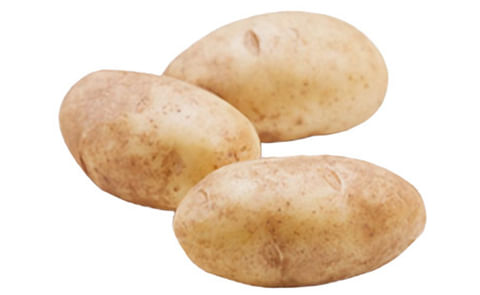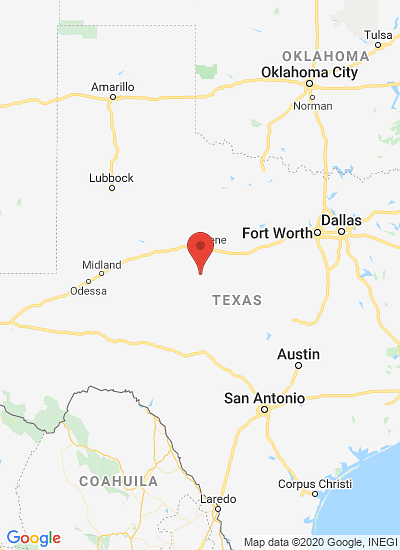Isabel Vales, Ph.D., Texas A&M AgriLife potato breeder, shows off the experimental clone COTX08063-2Ru, which could be selected to make french fries. (Courtesy: Texas A&M AgriLife photo by Kay Ledbetter)
Primaire tabs
Texas A&M Potato Breeding Program targets french fry, chipping, fresh markets
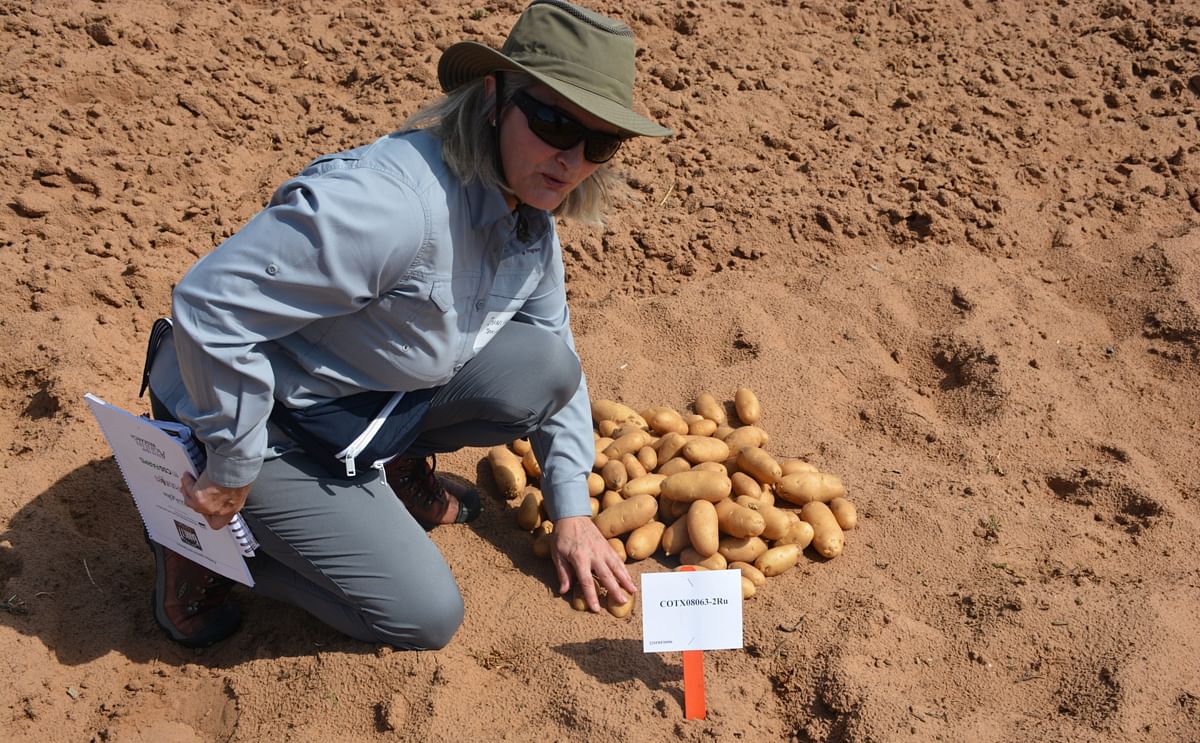
New potato varieties bred by the Texas A&M Potato Breeding Program could enter the french fry market before long, said Isabel Vales, Ph.D., Texas A&M AgriLife potato breeder in the Department of Horticultural Sciences in the Texas A&M College of Agriculture and Life Sciences.
At a recent field day in the southern High Plains near Springlake, Vales discussed the latest potato clones the breeding program has coming through the pipeline.
Isabel Vales:
"Historically, Texas has not been a player in that french fry market, Vales said, primarily because of the heavy competition from the Northwest, which is really strong in that market.
Isabel Vales:
High-starch potatoes are often used to make processed foods such as fries, chips and dehydrated potatoes. Potatoes with low to medium starch levels are frequently used for the fresh or table stock market.
Collaborating across state lines to reach numerous markets
Vales said the Texas A&M Potato Breeding Program is part of the Southwestern Regional Potato Cultivar Development Project, a multi-state project funded by the U.S. Department of Agriculture National Institute of Food and Agriculture.
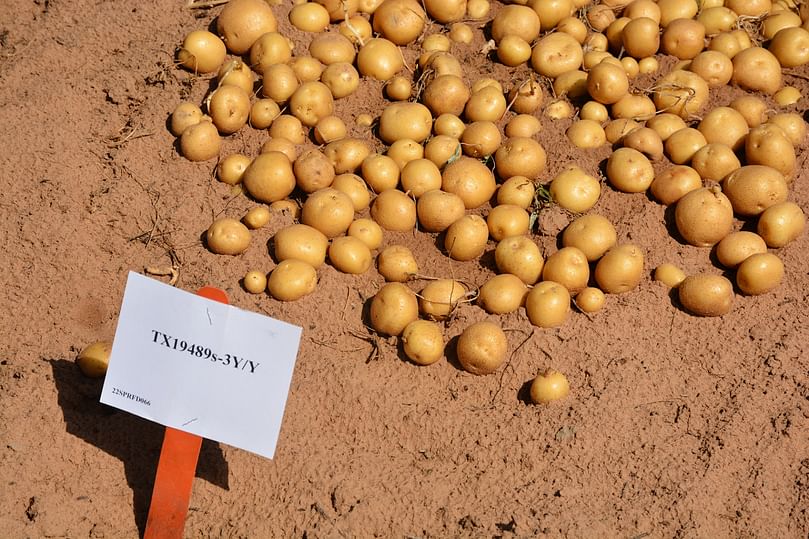 Isabel Vales:
Isabel Vales:
The regions are Northwestern — Washington, Oregon and Idaho; North Central — North Dakota, Wisconsin, Minnesota and Michigan; Northeastern — North Carolina, New York, Maine and Florida; and Southwestern — Texas, Colorado and California.
Isabel Vales:
Crosses and original selections are made in Colorado and Texas, followed by regional evaluation trials in all three states and additional states in the western region — Oregon, Idaho and Washington. Some french fry and chipping clones enter national trials every year.
Isabel Vales:
Isabel Vales:
Vales said the trials in various locations across the state and field days are the best way to let growers and the industry know about the latest potato clones in the breeding pipeline.
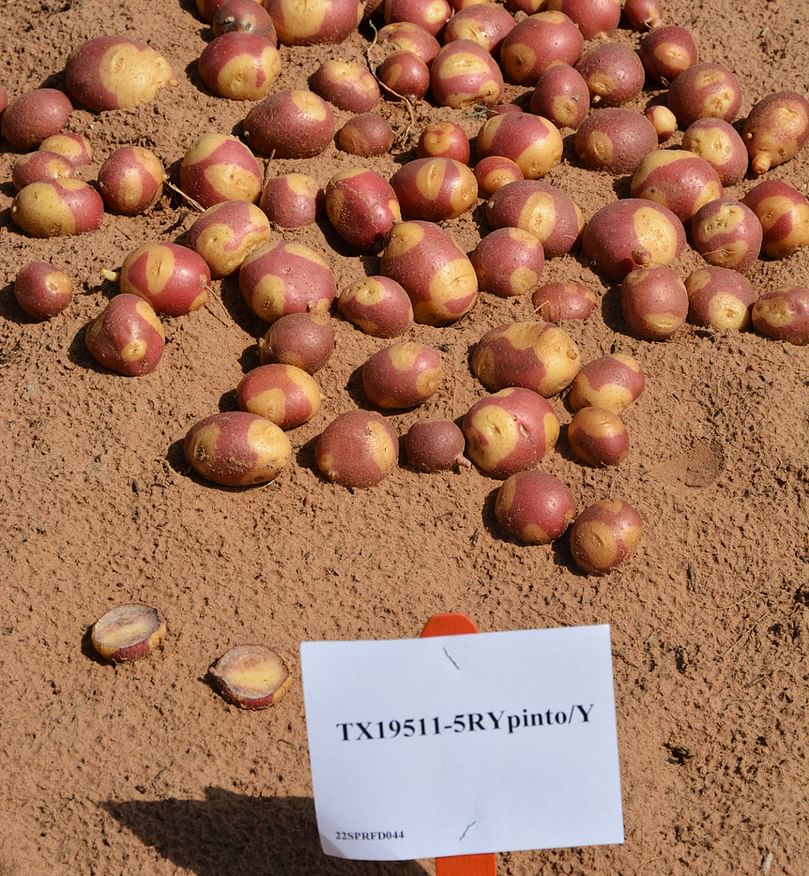 Isabel Vales:
Isabel Vales:
Early and advanced selected clones included in the field day are also evaluated in agronomic trials in Dalhart and the San Luis Valley, Colorado, as well as California around Bakersfield, South Central Valley and Tulelake, near the Oregon border.
Southwest region presents unique growing conditions, challenges for potatoes
She indicated that cooler nights favor higher yields and fewer tuber defects. Thus, in Texas, the yields get higher with elevation and latitude.
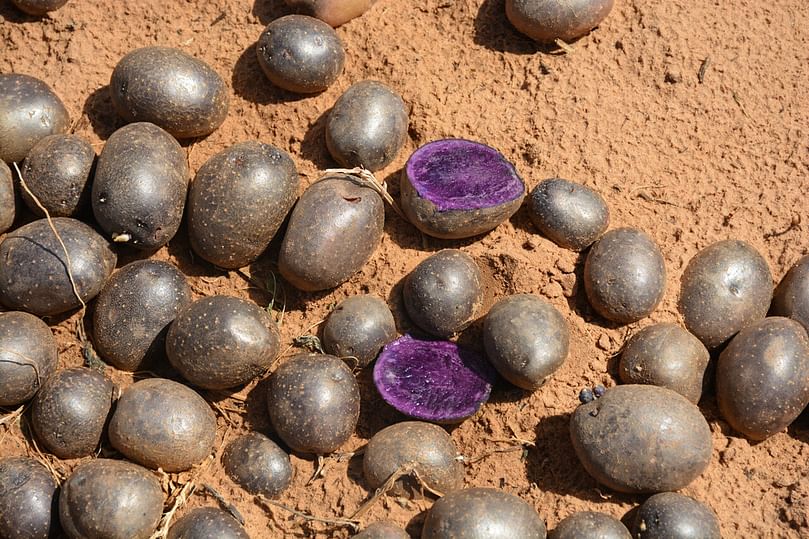 Isabel Vales:
Isabel Vales:
Sensitivity to internal tuber heat necrosis, growth cracks, reducing sugar build-up, brown center, hollow heart and heat sprouts are assessed from field-harvested tubers.
Isabel Vales:
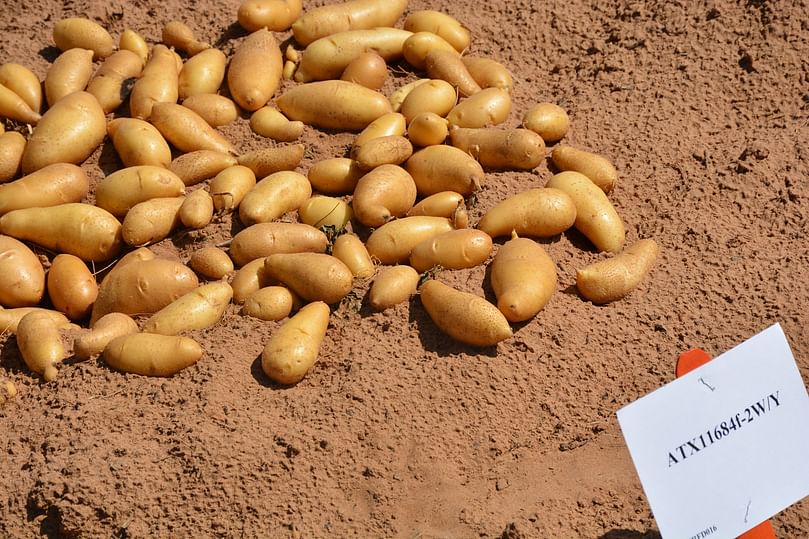 The Texas A&M Norkotah Russet strains continue to be the most popular, with 35 licensees in 12 states, she said. These are fresh-market russets.
The Texas A&M Norkotah Russet strains continue to be the most popular, with 35 licensees in 12 states, she said. These are fresh-market russets.
Two other fresh-market russets growing in popularity are the Reveille Russet, which doubled acreage from 2020 to 2021, and Vanguard Russet. The heat tolerance and long dormancy of Reveille Russet and Vanguard Russet are attractive features to growers across the U.S. and Canada.
Expanding potato markets beyond the Southwestern Region
Potato entries are evaluated in each state’s trials for numerous traits, including chip and french fry quality, Vales said. Top entries move to Southwestern for two years and Western Regional Trials for up to three years. Superior clones are released as new varieties.
Also, Colorado, Texas and California participate in National Chip Processing Trials and the National Fry Processors Trials. Advanced selections are also sent to collaborators all over the U.S. and Canada.
Vales said the Southwestern Region Project shares breeding stocks and advanced selections with a dozen other states. Since the inception of the Southwestern Regional Potato Cultivar Development Project, 66 new cultivars and clonal selections have been released or co-released with other institutions. Colorado and Texas are responsible for 44 of those.
Isabel Vales:
At a recent field day in the southern High Plains near Springlake, Vales discussed the latest potato clones the breeding program has coming through the pipeline.
Isabel Vales:
"We are quite excited about a light russet experimental potato clone that has a very special feature: a high percentage of starch and high gravity even under the very stressful high-temperature conditions in Texas."The potato’s experimental identification is COTX08063-2Ru. The initial cross was made in Colorado and the selection made in Texas."
"I think the french fry processing market, for which Texas has not released any processing russets, is a possibility."
"Historically, Texas has not been a player in that french fry market, Vales said, primarily because of the heavy competition from the Northwest, which is really strong in that market.
Isabel Vales:
"But also, in Texas, we cannot get the high solids required for the processing markets. Out of all of the varieties and experimental clones we evaluated over time, none of them had a high gravity."She said the amount of starch in potato tubers is the main factor determining a potato’s use. High solids or gravity means the potatoes are solid and dense. The potato yield is high, as is the starchy matter.
"The experimental clone COTX08063-2Ru has a high specific gravity, even under high heat stress conditions in Texas, and makes very good french fries. This is the second year this clone is in the National French Fry Potato Trials."
High-starch potatoes are often used to make processed foods such as fries, chips and dehydrated potatoes. Potatoes with low to medium starch levels are frequently used for the fresh or table stock market.
Collaborating across state lines to reach numerous markets
Vales said the Texas A&M Potato Breeding Program is part of the Southwestern Regional Potato Cultivar Development Project, a multi-state project funded by the U.S. Department of Agriculture National Institute of Food and Agriculture.

The Texas A&M Potato Breeding Program is part of a three-state Southwestern Regional Potato Cultivar Development Project. ( courtesy: Texas A&M AgriLife photo by Kay Ledbetter)
"The Southwestern program was established in 1997, and we are celebrating 25 years of successful collaborative work."In the U.S., Vales explained, there are four regional potato variety development groups involving 12 breeding programs in public land-grant universities and others within the USDA Agricultural Research Service.
The regions are Northwestern — Washington, Oregon and Idaho; North Central — North Dakota, Wisconsin, Minnesota and Michigan; Northeastern — North Carolina, New York, Maine and Florida; and Southwestern — Texas, Colorado and California.
Isabel Vales:
"In the southwestern region, we don’t have a USDA-ARS contribution like the others do."Texas A&M University, Colorado State University and the University of California at Davis initiated the Southwestern Regional Potato Cultivar Development Project to meet the unique needs of the region’s potato industry, Vales said.
Crosses and original selections are made in Colorado and Texas, followed by regional evaluation trials in all three states and additional states in the western region — Oregon, Idaho and Washington. Some french fry and chipping clones enter national trials every year.
Isabel Vales:
"In the U.S., most potato breeding programs are public. The level of cooperation in potato breeding is unparalleled; potatoes developed by the Southwestern program are planted all over the U.S. and Canada. In the Southwestern region, we also evaluate potatoes developed by other regional programs."She added that while federal funding is the program’s main source for public breeding, other funds come from state departments of agriculture, national commodity groups like Potatoes USA, foundations and in-kind support from growers. Additional funding comes from royalties derived from varieties released under plant variety protection, PVP, by the Texas A&M program.
Isabel Vales:
"To obtain PVP, we have to declare that the potato varieties are unique, distinct and stable. Seed growers planting PVP varieties must pay royalties. Texas A&M has been very successful in that regard. The amount we received this past year is more than USD 900,000, and part of that is reinvested in the program."Field day events introduce Texas A&M varieties, open market outlets
Vales said the trials in various locations across the state and field days are the best way to let growers and the industry know about the latest potato clones in the breeding pipeline.

Unique specialty potatoes like this dual-color skin round potato are a part of the Texas A&M AgriLife potato breeding program. (Courtesy: Texas A&M AgriLife photo by Kay Ledbetter)
"This year, we had 180 different clones in the field day display, representing fresh and processing market classes. Within the processing class, we had chippers and french fry types; within the fresh, we had reds, yellows, purples, smalls and fingerlings."Around 48 people from various U.S. states and Canada attended the Springlake event. The attendees expressed interest in some clones and shared priorities and challenges with the Texas A&M Potato Breeding Team and other participants.
Early and advanced selected clones included in the field day are also evaluated in agronomic trials in Dalhart and the San Luis Valley, Colorado, as well as California around Bakersfield, South Central Valley and Tulelake, near the Oregon border.
Southwest region presents unique growing conditions, challenges for potatoes
She indicated that cooler nights favor higher yields and fewer tuber defects. Thus, in Texas, the yields get higher with elevation and latitude.

A purple-meated potato is one of the unique clones the Texas A&M AgriLife potato breeding program is growing in field trials near Springlake. (Courtesy: Texas A&M AgriLife photo by Kay Ledbetter)
"We typically obtain much higher yields and better tuber quality out of the Dalhart trials located in the Texas Panhandle."High temperature during the growing season is a major abiotic stress in several of the Southwestern Region production areas, Vales said. Heat stress can trigger physiological defects and negatively affect tuber yield and quality.
Sensitivity to internal tuber heat necrosis, growth cracks, reducing sugar build-up, brown center, hollow heart and heat sprouts are assessed from field-harvested tubers.
Isabel Vales:
"The potato varieties we develop come in different tuber sizes, shapes, skin and flesh textures and colors that fit different market needs. For instance, we collaborate with Tasteful Selections, looking for clones with many small tubers."
"We are also growing fingerlings and bi-color potatoes. Recently, we developed a round russet with pink eyes and yellow flesh that was provided an exclusive release to explore new market opportunities."

Elongated fingerling potatoes grown in the Texas A&M AgriLife potato field trials near Springlake. (Courtesy: Texas A&M AgriLife photo by Kay Ledbetter)
Two other fresh-market russets growing in popularity are the Reveille Russet, which doubled acreage from 2020 to 2021, and Vanguard Russet. The heat tolerance and long dormancy of Reveille Russet and Vanguard Russet are attractive features to growers across the U.S. and Canada.
Expanding potato markets beyond the Southwestern Region
Potato entries are evaluated in each state’s trials for numerous traits, including chip and french fry quality, Vales said. Top entries move to Southwestern for two years and Western Regional Trials for up to three years. Superior clones are released as new varieties.
Also, Colorado, Texas and California participate in National Chip Processing Trials and the National Fry Processors Trials. Advanced selections are also sent to collaborators all over the U.S. and Canada.
Vales said the Southwestern Region Project shares breeding stocks and advanced selections with a dozen other states. Since the inception of the Southwestern Regional Potato Cultivar Development Project, 66 new cultivars and clonal selections have been released or co-released with other institutions. Colorado and Texas are responsible for 44 of those.
Isabel Vales:
"These potato cultivars represent a substantial and increasing part of the national potato acreage and have significantly contributed to regional and national economies."Several potato cultivars released by the Southwestern Region were listed in 2021 among the top 50 grown based on seed acreage in the U.S. Those developed in the region ranked second among the four regional projects, behind the Northwest and substantially ahead of the North Central and Northeast projects.
Like to receive news like this by email? Join and Subscribe!
Get the latest potato industry news straight to your WhatsApp. Join the PotatoPro WhatsApp Community!
Uitgelichte Bedrijven
Potato varieties mentioned
Sponsored Content
Sponsored Content
Sponsored Content
Sponsored Content





